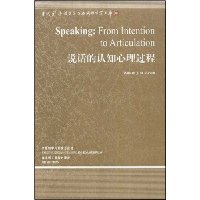| 商家名称 |
信用等级 |
购买信息 |
订购本书 |
|
|
 |
说话的认知心理过程(英文版) |
 |
|
 |
说话的认知心理过程(英文版) |
 |

基本信息·出版社:外语教学与研究出版社
·页码:566 页
·出版日期:2008年08月
·ISBN:7560077269/9787560077260
·条形码:9787560077260
·版本:第1版
·装帧:平装
·开本:16
·正文语种:英语
·丛书名:当代国外语言学与应用语言学文库
·外文书名:Speaking: From Intention to Articulation
内容简介 《说话的认知心理过程》出自荷兰著名心理语言学家 Willem. J. M. Levelt 之手,堪称心理语言学的经典之作,也是研究言语产出的必读书目。作者从心理语言学的角度系统考察了说话的复杂过程,不但对失语症、外语教学、口译、人工智能、话语分析等有直接的指导作用,而且由于侧重言语产出的过程,还能为语用学、语音学、音系学等带来新的视角、新的研究课题。
《说话的认知心理过程》行文深入浅出,内容翔实、细节周全,对从事语言学研究的高校师生具有重要的参考价值。
目录 reface
Acknowledgments
Author's Notes
Chapter 1 The Speaker as Information Processer
Chapter 2 The Speaker as Interlocutor
Chapter 3 The Structure of Messages
Chapter 4 The Generation of Messages
Chapter 5 Surface Structure
Chapter 6 Lexical Entries and Accessing Lemmas
Chapter 7 The Generation of Surface Structure
Chapter 8 Phonetic Plans for Words and Connected Speech
Chapter 9 Generating Phonetic Plans for Words
Chapter 10 Generating Phonetic Plans for Connected Speech
Chapter 11 Articulating
Chapter 12 Self-Monitoring and Self-Repair
Appendix Symbols from the International Phonetic Alphabet, with Examples
Bibliography
Author Index
Subject Index
……
序言 Talking is one of our dearest occupations. We spend hours a day convers-ing, telling stories, teaching, quarrelingand, of course, speaking toourselves. Speaking is, moreover, one of our most complex cognitive,linguistic, and motor skills. Articulation flows automatically, at a rate ofabout fifteen speech soimds per second, while we are attending only to theideas we want to get across to our interlocutors.
This fascinating human skill has not received the attention it deserveswithin psycholinguistics. Psycholinguistics is the science of human lan-guage production, comprehension, and acquisition, but the main body ofresearch and teaching relates primarily to the latter two topics. Languageproduction is the stepchild of psycholinguistics. Butterworth's (1980c,1983b) excellent two-volume anthology is the only source on the subject;there is no text and no coherently Written handbook.
When the European Science Foundation invited me to lecture on"speaking" at a summer course in psycholinguistics to be held in Brusselsin 1985, I gladly accepted and began writing what I thought would be anintroductory text. A year and a half would suffice, I thought, in view of therather limited psycholinguistic literature on the subject.
My main discovery was that the literature on speaking is gigantic. Butthe majority of it is not to be found in standard psycholingnistic sources.Other disciplines have asked the questions that psycholinguists haveignored. Students of conversational analysis, pragrnatics, discourse se-mantics, artificial intelligence, syntax, phonology, speech communication,and phonetics have contributed myriad theoretical insights and empiricalfindings. The major problem with this huge literature, however, is that itis compartmentalizedhphoneticians ignore phonology, conversationalanalysts ignore discourse semantics and phonetics, students of AI ignorepsycholingnistics, and so on.
文摘 插图:






